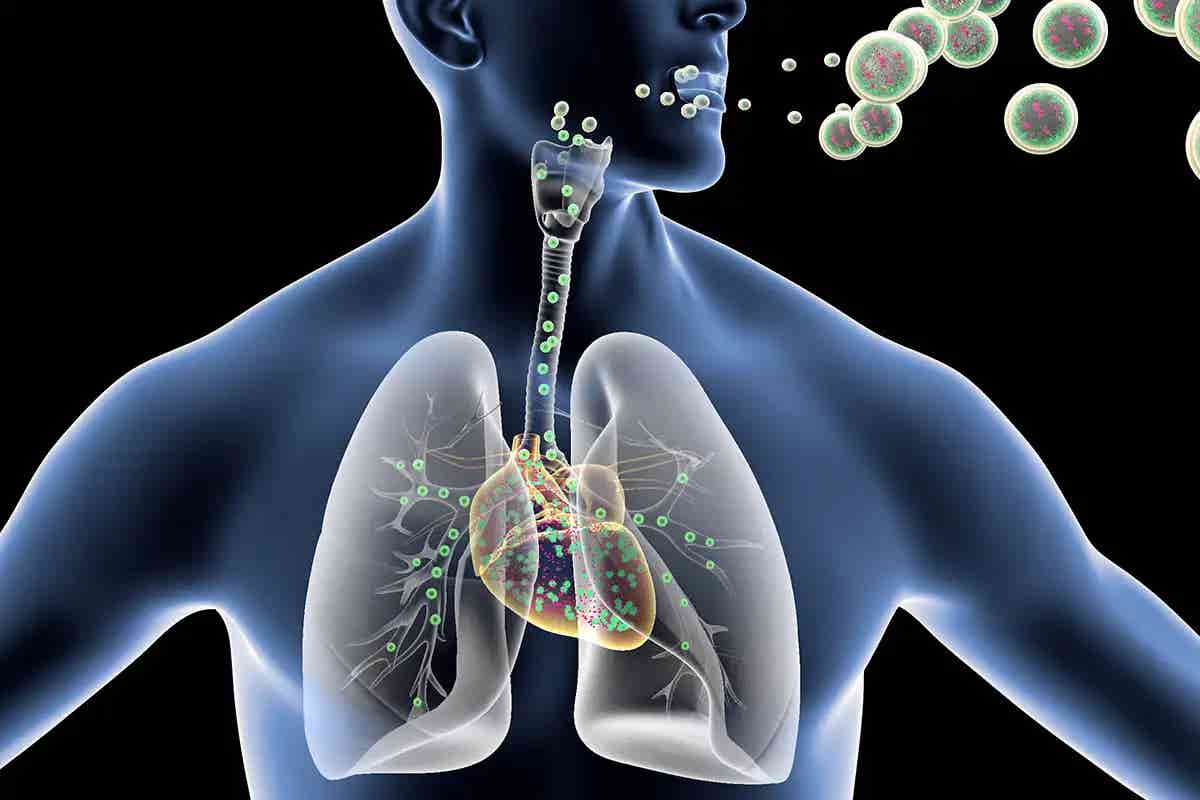Inhalable nanoparticles revolutionize treatment for cystic fibrosis and other lung diseases
This is the first demonstration of highly efficient delivery of RNA to the lungs used to treat or repair a range of genetic diseases.

[Apr. 1, 2023: JD Shavit, The Brighter Side of News]
A new type of nanoparticle that can be administered to the lungs to deliver messenger RNA encoding useful proteins. (CREDIT: Creative Commons)
MIT and UMass Medical School engineers have developed a new type of nanoparticle that can be administered to the lungs to deliver messenger RNA encoding useful proteins, according to a new study published in Nature Biotechnology. The researchers claim that with further development, the nanoparticles could offer an inhalable treatment for cystic fibrosis and other lung diseases.
“This is the first demonstration of highly efficient delivery of RNA to the lungs in mice. We are hopeful that it can be used to treat or repair a range of genetic diseases, including cystic fibrosis,” said Daniel Anderson, a professor in MIT’s Department of Chemical Engineering and a member of MIT’s Koch Institute for Integrative Cancer Research and Institute for Medical Engineering and Science (IMES).
One of the main challenges in using messenger RNA as a therapeutic for treating diseases caused by faulty genes has been the difficulty in delivering it to the right part of the body without off-target effects. Injected nanoparticles often accumulate in the liver, so several clinical trials evaluating potential mRNA treatments for liver diseases are currently underway.
RNA-based Covid-19 vaccines, which are injected directly into muscle tissue, have also proven effective. In many of those cases, mRNA is encapsulated in a lipid nanoparticle – a fatty sphere that protects mRNA from being broken down prematurely and helps it enter target cells.
Related Stories:
Several years ago, Anderson’s lab set out to design particles that would be better able to transfect the epithelial cells that make up most of the lining of the lungs. In 2019, his lab created nanoparticles that could deliver mRNA encoding a bioluminescent protein to lung cells. Those particles were made from polymers instead of lipids, which made them easier to aerosolize for inhalation into the lungs.
However, more work is needed on those particles to increase their potency and maximize their usefulness.
In their new study, the researchers set out to develop lipid nanoparticles that could target the lungs. The particles are made up of molecules that contain two parts: a positively charged headgroup and a long lipid tail. The positive charge of the headgroup helps the particles to interact with negatively charged mRNA, and it also helps mRNA to escape from the cellular structures that engulf the particles once they enter cells.
Engineers at MIT and the University of Massachusetts Medical School have designed a new type of nanoparticle that can be administered to the lungs, where it can deliver messenger RNA encoding useful proteins. (CREDIT: iStock images)
The lipid tail structure, meanwhile, helps the particles to pass through the cell membrane. The researchers came up with 10 different chemical structures for the lipid tails, along with 72 different headgroups. By screening different combinations of these structures in mice, the researchers were able to identify those that were most likely to reach the lungs.
After one dose of mRNA, about 40 percent of lung epithelial cells were transfected, the researchers found. Two doses brought the level to more than 50 percent, and three doses up to 60 percent. The most important targets for treating lung disease are two types of epithelial cells called club cells and ciliated cells, and each of these was transfected at about 15 percent.
LNP-enabled gene editing in mouse airway epithelium. (CREDIT: Nature Communications)
“This means that the cells we were able to edit are really the cells of interest for lung disease,” said Bowen Li, a former MIT postdoc who is now an assistant professor at the University of Toronto and one of the paper’s lead authors. “This lipid can enable us to deliver mRNA to the lung much more efficiently than any other delivery system that has been reported so far.”
The new particles also break down quickly, allowing them to be cleared from the lung within a few days and reducing the risk of inflammation. The particles could also be delivered multiple times to the same patient if repeat doses are needed. This gives them an advantage over another approach to delivering mRNA, which uses a modified version of harmless adenoviruses. Those viruses are very effective at delivering RNA but can’t be given repeatedly because they induce an immune response in the host.
Representative IVIS images of the third-round in vivo testing (intramuscular injection, 0.25 mg/kg mLuc per mouse) from two mice per group. (CREDIT: Nature Communications)
To deliver the particles in this study, the researchers used a method called intratracheal instillation, which involves inserting a catheter into the trachea and administering the nanoparticles directly into the lungs. While effective, this method is invasive and not practical for clinical use.
Therefore, the researchers are now working on developing a more patient-friendly approach to delivering the nanoparticles. One possibility is to aerosolize the nanoparticles and deliver them using a nebulizer, a device that converts liquid medication into a fine mist that can be inhaled into the lungs. This would be a non-invasive and easy-to-administer method for patients to receive the therapy.
Anderson and his team are also working on optimizing the nanoparticle design to increase their potency and reduce any potential side effects. One potential concern with mRNA therapies is the risk of inducing an immune response or inflammation. However, the researchers found that their nanoparticles broke down quickly and were cleared from the lungs within a few days, reducing the risk of these adverse effects.
Another advantage of the nanoparticle approach is that it can be used to deliver a wide range of therapeutic molecules, not just mRNA. For example, the particles could be loaded with small interfering RNA (siRNA), which can silence disease-causing genes. Alternatively, the particles could be used to deliver therapeutic proteins or other drugs directly to the lungs.
The potential applications of this technology are vast, and the researchers are already exploring its use in a variety of lung diseases. One disease they are particularly interested in is cystic fibrosis, a genetic disorder that affects the lungs and other organs. Cystic fibrosis is caused by mutations in the CFTR gene, which encodes a protein that regulates the transport of ions in and out of cells. The faulty CFTR protein leads to the buildup of thick mucus in the lungs, which can cause infections and other complications.
There is currently no cure for cystic fibrosis, and existing treatments focus on managing the symptoms of the disease. However, mRNA therapies offer the potential to correct the underlying genetic defect and provide a more effective long-term solution.
Anderson and his colleagues plan to test their nanoparticle approach in a mouse model of cystic fibrosis, with the goal of correcting the CFTR gene mutation and improving lung function. If successful, this could pave the way for clinical trials in humans.
Representative IVIS images of the fourth-round in vivo testing (intratracheal administration, 0.25 mg/kg mLuc per mouse) from two mice per group. (CREDIT: Nature Communications)
In addition to cystic fibrosis, the researchers are also exploring the use of their nanoparticles in other lung diseases, such as idiopathic pulmonary fibrosis (IPF), a condition that causes scarring of the lung tissue and can lead to breathing difficulties. IPF currently has no cure, and existing treatments only slow the progression of the disease.
The researchers believe that their nanoparticle approach could offer a more effective way to treat IPF by delivering therapeutic molecules directly to the lung tissue. They also plan to investigate the use of mRNA vaccines that could be delivered directly to the lungs, offering a potential new approach to prevent respiratory infections.
Overall, the development of these nanoparticles represents a significant step forward in the field of gene therapy and offers hope for the treatment of a wide range of genetic diseases. While much more research is needed to fully explore the potential of this technology, the early results are promising, and the researchers are optimistic about its future applications.
Note: Materials provided above by The Brighter Side of News. Content may be edited for style and length.
Like these kind of feel good stories? Get the Brighter Side of News' newsletter.
Joseph Shavit
Head Science News Writer | Communicating Innovation & Discovery
Based in Los Angeles, Joseph Shavit is an accomplished science journalist, head science news writer and co-founder at The Brighter Side of News, where he translates cutting-edge discoveries into compelling stories for a broad audience. With a strong background spanning science, business, product management, media leadership, and entrepreneurship, Joseph brings a unique perspective to science communication. His expertise allows him to uncover the intersection of technological advancements and market potential, shedding light on how groundbreaking research evolves into transformative products and industries.



